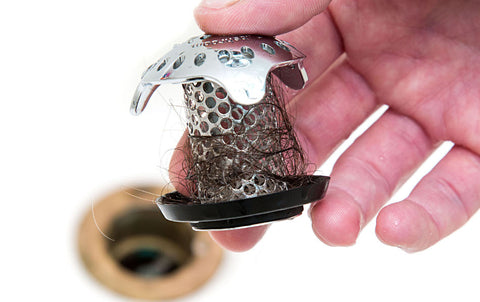
What to Do When Your Toilet Won’t Unclog
Share
It happens to almost everyone at one time or another. You flush your toilet and the waste doesn’t go down the drain. Instead, the toilet bowl overfills or even overflows with dirty water. When a toilet won't unclog, it can be very annoying and embarrassing.
In this article, we will explore the most common causes of clogged toilets, how to prevent them, and how to clear clogs when they happen.
Common Reasons Why a Toilet Won't Unclog
To deal with clogs effectively, you need to be aware of the possible causes. Let’s look at some of the possible reasons why a toilet won't unclog:
Flushing Non-Flushable Items

When a toilet won't unclog, there’s likely an unflushable item to blame. For example, you should never flush feminine products like tampons and pads. Such items tend to expand when they absorb water, which keeps them from flowing down the drain. In addition, it takes quite a while for them to break down in the sewer system.
Other items you should not be flushing down your toilet are cleaning wipes and paper towels. Even when wipes are advertised as “flushable,” they can still clog your toilet. Throw wipes and paper towels into the trash after use.
Cotton balls and Q-tips are also common culprits in toilet clogs. When these items absorb water, they can easily clump together and cause problems.
Blockages on the Plumbing Vent
Also known as the vent stack, a plumbing vent is a pipe that usually extends to the outside of your home. Just like drain pipes get rid of waste and water from your home, a vent stack gets rid of sewer gases and odors. It also allows air into the plumbing system, which makes it easier for water to flow smoothly through the drain pipes.
Since your plumbing vent is on the roof, it could get clogged by different kinds of debris. These include bird nests, sticks, leaves, stones, or soil. When this happens, the water flow could be interrupted due to the negative pressure build up in the drainage system.
Hard Water Problems
If your water doesn’t lather easily and leaves white spots on your clothes or dishes, it is probably hard water. Hard water contains minerals such as calcium and magnesium as sulfates, chlorides, and bicarbonates. Ferrous iron could also be present. These minerals often calcify over time, forming a white substance. Too much of the calcified substance will narrow your pipes. This is sometimes the reason why your toilet won't unclog.
Excessive Toilet Paper Use
When used in the proper amounts, toilet paper should go down the drain without any problem. However, when you use too much of it, it will not dissolve properly and could clog your toilet. While many people use up to 10 squares of toilet paper per wipe, three to five squares could actually be enough. And, make a habit of folding toilet paper instead of balling it up — this could contribute to clogs.
Clogs in Your Main Sewer Line
Tree root infiltration is one of the most common causes of clogged sewer lines. As tree roots search for sources of water, they are likely to grow into the pipe and cause a blockage. Corrosion of an older pipe could also cause a sewer line to break, thus allowing soil and other debris into the pipe.
How to Prevent a Toilet Clog
When it comes to clogged toilets, prevention is better than cure. So, how do you prevent toilet clogs?
Conduct Inspections Twice a Year
Your toilet is made up of components like the handle and flush rod, flush valve, lift chain, shutoff valve, refill tube, float ball, and toilet bowl. Conduct an inspection of these parts at least twice a year to ensure that everything is working properly. You might have to replace or upgrade some fixtures for optimum functionality.
Use the Double-Flush
Flushing the toilet twice is a simple, but very effective way of preventing clogs. After defecating, flush the toilet before using toilet paper. Then, throw toilet paper down the bowl and flush again. Alternatively, you could split the use of toilet tissue between two rounds of flushing.
Install a Water Softening System
A water softening system removes minerals from hard water as it enters your main water supply line. This system comes in a wide range of styles and sizes to accommodate the size of your home. It can be installed in the utility closet, garage, basement, or wherever water enters the house.
Please note that a water softening system must be installed by a licensed plumber. It will cost you about $2,000 for the system plus installation.
Keep the Toilet Bowl Covered
Small objects could accidentally fall into an open toilet, and you might not realize it before you flush. When items like empty boxes, small toys, dental floss, and toothbrushes get flushed, they are likely to get stuck in your pipes. You can avoid such problems by keeping your toilet bowl closed when it’s not in use. In addition, be sure to educate the members of your household on what should not be flushed down the toilet.
Manage Tree Roots
As mentioned earlier, tree roots can grow and intrude on your drain pipes, thus clogging them. To avoid such problems, you will need to hire a professional plumber to inspect your sewer line. Look out for warning signs that a toilet won't unclog, like a gurgling sound anytime you flush the toilet.
How to Fix Clogged Toilets
When it comes to unclogging a toilet, you can use DIY solutions or hire a professional plumber. The latter option could mean parting with up to $200 per hour on plumbing fees. The good news is many home remedies can help with a toilet that won’t flush. Let’s explore a few.
Plunger
Though it may seem obvious, a plunger is one of the best tools to use when a toilet won't unclog. Here are the steps for plunging a toilet:
- Wear rubber gloves.
- Run the plunger under hot water in order to soften the rubber. This will make it easier to create a good seal.
- Insert the rubber part into the bowl until it is submerged in water
- Push down the plunger until it completely covers the toilet trap opening
- Once you create an airtight vacuum, push down the plunger and pull it out quickly. Repeat this action 10-15 times.
- Flush the toilet to see if it is draining normally. If it is not, you might have to plunge several times more.
When it comes to plungers, there are many products to choose from. For a toilet plunger that will get the job done in seconds, try ToiletShroom. This handy plunger doubles as a squeegee that helps clean up the insides of your toilet.
Plumbing Snake
Also known as a toilet auger, a plumbing snake is a flexible wire that is used to unclog toilets. This flexible tool can maneuver beyond the toilet trap to reach clogs deep down the drain. Plumbing snakes usually have a rubber coating to protect the toilet from damages and scratches.
After wearing your rubber gloves, put the toilet snake into the toilet bowl and push it in gently until you feel resistance. Twist the handle in order to push the obstruction down the toilet drain. When the plumbing snake can move freely without any resistance, pull it out and flush the toilet. If the water flows fast, you’ve cleared the clog. If the toilet won't unclog, you might have to repeat the process.
Dish Soap and Hot Water
If a plunger or plumbing snake doesn’t work, water and soap might do the trick. Boil a gallon of water and allow it to cool for about 10 minutes. As you wait, pour a cup of liquid dish soap into the toilet bowl. You can then pour the water slowly into the bowl — leave it for about 20 minutes before flushing. The combination of warm water and soap can loosen the clog, making it easier to flush.
Chemical Drain Cleaner
If all else fails, consider using a chemical drain cleaner. Such cleaners are usually very effective in softening any solid obstructions in your toilet. Leading drain cleaners include Drano Max Gel Clog Remover, Bio-Clean, CLR Clear Pipes & Drains, and Green Gobbler. However, most of these products contain toxic ingredients that could be harmful to pets, humans and even your drain pipes.
When you buy a drain cleaner, read the manufacturer’s instructions carefully. Be sure to pour only the recommended amount into the toilet bowl. To avoid touching or inhaling the chemical, wear rubber gloves and a mask. You should also open all the windows to ensure the bathroom is well-ventilated.
Keep Your Toilet Unclogged
So, let’s recap the common reasons why a toilet won't unclog — excessive toilet paper use, non-flushable solids, hard water, and clogs in the main sewer line. Thankfully, they can be prevented via methods like double-flushing, covering the toilet bowl, routine inspections and dealing with tree roots.
If you ever find yourself with a toilet clog, you could use soap and hot water, baking soda, a plumbing snake, chemical drain cleaners, or a plunger.
Are you looking to eliminate plumbing problems and clogged drains for good? Look no further than our complete 'Shroom drain protection line! We have award-winning solutions for every drain in your home.
Say Goodbye to Clogged Drains Forever
We here at the TubShroom Company have made it our mission to protect every drain in the world from clogs. We know how annoying it can be to see that dirty water start backing up. Hair is the #1 cause of clogged drains, so we set out to develop products that can catch every hair, every time. Learn more about our TubShroom family of products here.
When your bathtub, shower, sink, or toilet drain clogs, you either try a "snake" device to clear it out or--more typically--you pour harmful chemicals down the drain to try to dissolve the clog. When those attempts fail, the next step most people take is to call on a plumber who may charge upwards of $200 to clear the clog. TubShroom products can prevent clogs before they occur.
View all our top-selling, award-winning TubShroom products here. From the TubShroom to SinkShroom, and DrainShroom to ToiletShroom, there's something for everyone. Click here to product your drains for good.
Disclosure: Links in this article are affiliate links to Amazon products. As an Amazon Associate, we earn from qualifying purchases.
More Articles from The Shroom Company
How to Unclog a Toilet Without a Plunger
5 Common Plumbing Problems and How To Avoid Them







